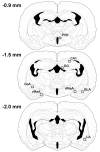Effects of dominance status on conditioned defeat and expression of 5-HT1A and 5-HT2A receptors
- PMID: 21362435
- PMCID: PMC3118936
- DOI: 10.1016/j.physbeh.2011.02.033
Effects of dominance status on conditioned defeat and expression of 5-HT1A and 5-HT2A receptors
Abstract
Past experience can alter how individuals respond to stressful events. The brain serotonin system is a key factor modulating stress-related behavior and may contribute to individual variation in coping styles. In this study we investigated whether dominant and subordinate hamsters respond differently to social defeat and whether their behavioral responses are associated with changes in 5-HT1A and 5-HT2A receptor immunoreactivity in several limbic brain regions. We paired weight-matched hamsters in daily aggressive encounters for two weeks so that they formed a stable dominance relationship. We also included controls that were exposed to an empty cage each day for two weeks. Twenty-four hours after the final pairing or empty cage exposure, subjects were socially defeated in 3, 5-min encounters with a more aggressive hamster. Twenty-four hours after social defeat, animals were tested for conditioned defeat in a 5-min social interaction test with a non-aggressive intruder. We collected brains following conditioned defeat testing and performed immunohistochemistry for 5-HT1A and 5-HT2A receptors. We found that dominants showed less submissive and defensive behavior at conditioned defeat testing compared to both subordinates and controls. Additionally, both dominants and subordinates had an increased number of 5-HT1A immunopositive cells in the basolateral amygdala compared to controls. Subordinates also had more 5-HT1A immunopositive cells in the dorsal medial amygdala than did controls. Finally, dominants had fewer 5-HT1A immunopositive cells in the paraventricular nucleus of the hypothalamus compared to controls. Our results indicate that dominant social status results in a blunted conditioned defeat response and a distinct pattern of 5-HT1A receptor expression, which may contribute to resistance to conditioned defeat.
Copyright © 2011 Elsevier Inc. All rights reserved.
Figures






References
-
- Huhman KL. Social conflict models: Can they inform us about human psychopathology? Hormones and Behavior. 2006;50:640–6. - PubMed
-
- Shively CA, Laber-Laird K, Anton RF. Behavior and physiology of social stress and depression in female cynomolgus monkeys. Biological Psychiatry. 1997;41:871–82. - PubMed
-
- Steklis HD, Raleigh MJ, Kling AS, Tachiki K. Biochemical and hormonal correlates of social behavior in all-male groups of squirrel monkeys (Saimiri sciureus) American Journal of Primatology. 1986;11:133–45. - PubMed
-
- Sapolsky RM, Alberts S, Atlmann J. Hypercortisolism associated with social subordinance or social isolation among wild baboons. Archives of General Psychiatry. 1997;54:1137. - PubMed
-
- Bercovitch FB, Clarke AS. Dominance rank, cortisol concentrations, and reproductive maturation in male rhesus macaques. Physiology & Behavior. 1995;58:215–21. - PubMed
Publication types
MeSH terms
Substances
Grants and funding
LinkOut - more resources
Full Text Sources
Miscellaneous

